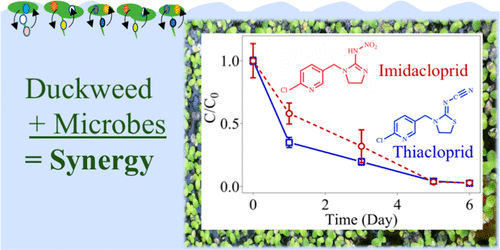当前位置:
X-MOL 学术
›
Environ. Sci. Technol. Lett.
›
论文详情
Our official English website, www.x-mol.net, welcomes your
feedback! (Note: you will need to create a separate account there.)
Synergistic Lemna Duckweed and Microbial Transformation of Imidacloprid and Thiacloprid Neonicotinoids
Environmental Science & Technology Letters ( IF 8.9 ) Pub Date : 2019-11-18 , DOI: 10.1021/acs.estlett.9b00638 Claire P. Muerdter 1, 2 , Gregory H. LeFevre 1, 2
Environmental Science & Technology Letters ( IF 8.9 ) Pub Date : 2019-11-18 , DOI: 10.1021/acs.estlett.9b00638 Claire P. Muerdter 1, 2 , Gregory H. LeFevre 1, 2
Affiliation

|
Neonicotinoids are the most widely used insecticides in the world and are commonly measured in aquatic environments, including freshwater wetlands. We report for the first time the synergistic transformation of neonicotinoids by a Lemna duckweed and microbial system collected from an agricultural pond in Iowa, USA. Imidacloprid and thiacloprid were removed at statistically indistinguishable rates (0.63 ± 0.07 and 0.62 ± 0.05 day–1, respectively) from hydroponic medium only when in the presence of both duckweed and its associated microbial community. As evidence for this duckweed–microbial synergy, experiments with surface-sterilized duckweed, duckweed-associated microbes, pond water microbes alone, and two other plant species (Typha sp. and Ceratophyllum demersum) did not yield significant neonicotinoid removal beyond initial biomass sorption. Degradation of imidacloprid and thiacloprid by the duckweed–microbial system generated multiple, known neonicotinoid metabolites (desnitro-imidacloprid, imidacloprid urea, thiacloprid amide, and 6-chloronicotinic acid). Measured metabolites with increased insect or vertebrate toxicity were either absent (imidacloprid olefin) or present only in small amounts (desnitro-imidacloprid; <1% of the parent). The neonicotinoid parent and metabolite mass balance did not fully account for total neonicotinoid removal, suggesting mineralization and/or other unidentified transformation products with unknown toxicity. This novel duckweed- and microbe-facilitated neonicotinoid degradation may represent an important contribution to the environmental fate of neonicotinoids.
中文翻译:

协同浮游浮萍和吡虫啉和噻虫啉新烟碱类的微生物转化
新烟碱是世界上使用最广泛的杀虫剂,通常在包括淡水湿地在内的水生环境中进行测量。我们首次报道了从美国爱荷华州的一个农业池塘收集的Lemna浮萍和微生物系统对新烟碱类的协同转化。仅当浮萍及其相关微生物群落同时存在时,吡虫啉和噻虫啉才以统计学上无法区分的速率(分别为0.63±0.07和0.62±0.05天–1)从水培培养基中去除。作为这种浮萍与微生物协同作用的证据,我们进行了表面灭菌浮萍,浮萍相关微生物,池塘水微生物以及其他两种植物(香蒲属和香蒲属)的实验。角藻)在最初的生物量吸附作用之后没有产生显着的新烟碱去除作用。浮萍-微生物系统对吡虫啉和噻虫啉的降解产生了多种已知的新烟碱类代谢产物(去硝基吡虫啉,吡虫啉尿素,噻虫啉酰胺和6-氯烟酸)。缺少测得的具有提高的昆虫或脊椎动物毒性的代谢产物(吡虫啉烯)或仅少量存在(去硝基吡虫啉; <1%的母体)。新烟碱母体和代谢物的质量平衡并未完全说明总的新烟碱去除量,表明矿化作用和/或其他未知毒性的转化产物。这种新的浮萍和微生物促进的新烟碱降解可能代表了对新烟碱的环境命运的重要贡献。
更新日期:2019-11-18
中文翻译:

协同浮游浮萍和吡虫啉和噻虫啉新烟碱类的微生物转化
新烟碱是世界上使用最广泛的杀虫剂,通常在包括淡水湿地在内的水生环境中进行测量。我们首次报道了从美国爱荷华州的一个农业池塘收集的Lemna浮萍和微生物系统对新烟碱类的协同转化。仅当浮萍及其相关微生物群落同时存在时,吡虫啉和噻虫啉才以统计学上无法区分的速率(分别为0.63±0.07和0.62±0.05天–1)从水培培养基中去除。作为这种浮萍与微生物协同作用的证据,我们进行了表面灭菌浮萍,浮萍相关微生物,池塘水微生物以及其他两种植物(香蒲属和香蒲属)的实验。角藻)在最初的生物量吸附作用之后没有产生显着的新烟碱去除作用。浮萍-微生物系统对吡虫啉和噻虫啉的降解产生了多种已知的新烟碱类代谢产物(去硝基吡虫啉,吡虫啉尿素,噻虫啉酰胺和6-氯烟酸)。缺少测得的具有提高的昆虫或脊椎动物毒性的代谢产物(吡虫啉烯)或仅少量存在(去硝基吡虫啉; <1%的母体)。新烟碱母体和代谢物的质量平衡并未完全说明总的新烟碱去除量,表明矿化作用和/或其他未知毒性的转化产物。这种新的浮萍和微生物促进的新烟碱降解可能代表了对新烟碱的环境命运的重要贡献。











































 京公网安备 11010802027423号
京公网安备 11010802027423号